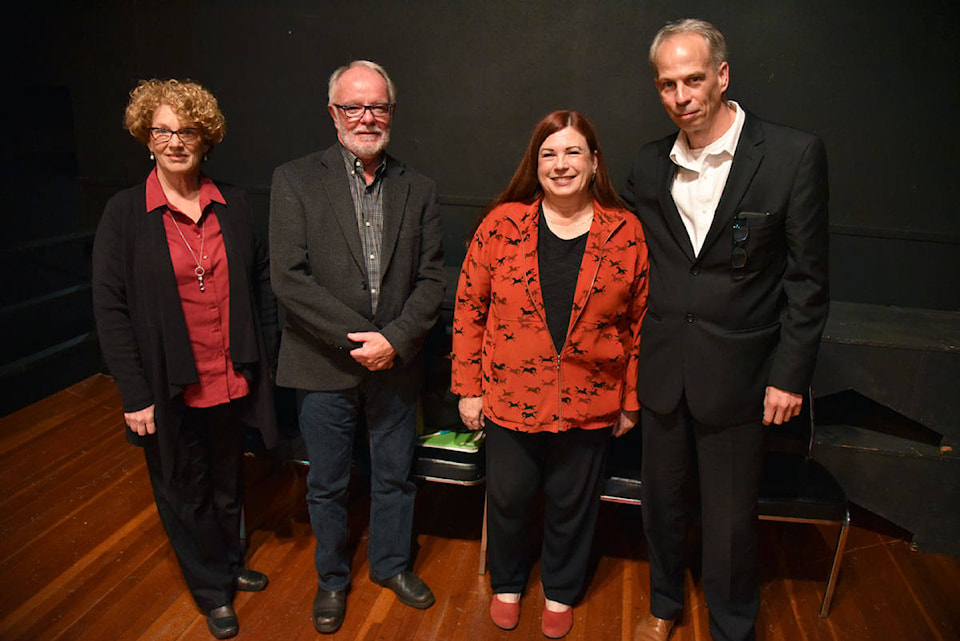Saltair voters gathered under the roof of the community centre, a building that has been a sticking point for some, to hear from electoral area director candidates hoping to unite them in the years going forward.
Together on stage for the all-candidates forum hosted by the Saltair District Ratepayers Association were Sean Jonas, Lynne Smith, Rod Smith and Lia Versaevel.
The candidates faced a steady flow of questions about water for the early part of the debate with other queries from the floor coming on the local trail system, development, anchorages and potential for future investment in the community centre.
Sean Jonas said it was important to back up Area G’s water supply and the issue needed to be dealt with in a “reasonable” manner even if the community’s grant application for a filtration system wasn’t successful.
“We have to be very conscious of having clean water. That’s why Island Health has said we’ve got to do this. When it comes down to it, we’ve got the wells that have been built,” Jonas said. “I think at the end of the day if we can combine the ground water with filtration we can cut the cost of filtration. If we get the grant for filtration I’m all for doing it but I’m also all for doing both.”
The CVRD has laid out three options for Saltair’s ongoing clean water supply, including joining up with Ladysmith’s system, groundwater, or a standalone filtration system estimated at upwards of $6-million.
Rod Smith said he was in favour of the “perfectly good water we have right now” but also preferred filtration.
“I also believe strongly that there’s other grant money available,” adding that he’d recently found another grant that would be funded exclusively by the federal and provincial governments. “I honestly don’t think given the type of movement by VIHA in the past on other issues that we’re under the gun to get this done immediately. The water is fine, we’re still drinking it, and I believe we should move forward with the filtering system and know we always have well water as a backup.”
Versaevel said water supply is an issue facing all of Vancouver Island.
“I believe that working together we can all come to a better understanding of how to use the water that we have, how to change bylaws and regulations around groundwater use and also use our imaginations better around grey water,” she said. “There are technologies in place that we could be using to better manage the water resources that we have.”
Lynne Smith said Area G has the largest pure water supply of all the CVRD electoral areas but said options such as drilling well is extremely costly for taxpayers.
“The water that we are receiving in our pipes, we are having issues with because of our distribution system. Our distribution system is old and we do need to address the upgrades and we need to revisit the whole topic of the upgrades as we find we’re running out of money,” she said.
The CVRD purchasing the old school property for $300,000 back in 2014 still seems to also be a point of contention for voters.
One person asked candidates ‘yes’ or ‘no’ if they would consider revisiting the purchase of the school with a referendum soon after the election was over.
“My short answer is no but I think you want a little bit more than that…” said Versaevel before being interrupted by the questioner who wasn’t interested in hearing the reason.
A petition four years ago garnered over 600 votes from local residents opposed to buying the school.
“At the end of the day we have to move forward not backwards. We own the building - it’s ours,” said Jonas, adding that he thinks cost savings can be found for future maintenance.
Some reports have estimated that it could cost $3-million to do repairs and upgrades to the building but the roof was repaired for much less than originally thought.
Lynne Smith referenced the report as an important marker in the state of the aging building.
“It is the only professional engineering report that we have received as a community and that report indicated that $3-million was required. We do not have that amount of money for a building that is still continuing to age,” she said.
Rod Smith said more information was needed and he was “shocked” by the $3-million price tag and called the building a “community asset”
“I’ve been involved in other community assets and infrastructure programs over the 38 years and found millions of grant money and sponsorship to get it done,” he said. “I would say no to fixing up this building totally with tax dollars. I think there’s a happy mix in between.”
